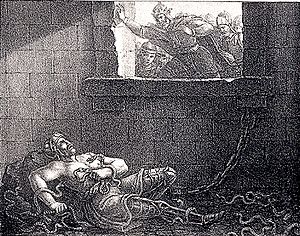Ælla of Northumbria facts for kids
Quick facts for kids Ælla |
|
|---|---|
| King of Northumbria | |
| Reign | 862–867 AD |
| Predecessor | Osberht |
| Successor | Ecgberht |
| Born | c. 815 |
| Died | 21 March 867 (aged 51–52) York, Northumbria |
| House | Northumbria |
Ælla (also spelled Ælle or Aelle) was a king of Northumbria, an old kingdom in what is now England. He ruled in the middle of the 9th century, from about 862 to 867 AD. We don't know much about his family or exactly when he became king because historical records from that time are limited.
Ælla is mentioned in old English writings, like the Anglo-Saxon Chronicle. He also appears in exciting Norse sagas, which are traditional stories from Scandinavia. These sagas tell a dramatic tale about Ælla capturing and killing a famous Viking leader named Ragnar Lodbrok. According to the sagas, Ragnar's sons later invaded Northumbria to get revenge.
Contents
Who Was King Ælla?
Ælla became king after the previous ruler, Osberht, was removed from power. Historians believe Ælla's rule started around 862 or 863 AD. However, the exact dates for kings in Northumbria before 867 AD are not very clear. Some records even suggest he might have become king as late as 866 AD.
We know very little about what Ælla did during his time as king. One old record says that he took lands belonging to the church. Most historical accounts describe Ælla as a "tyrant," meaning he was a harsh ruler, and an "illegitimate king," suggesting he might not have had a proper right to the throne. However, one source says he was actually Osberht's brother.
The Great Heathen Army Arrives
In the middle of 866 AD, a huge army of Vikings landed in Northumbria. This army was known as the Great Heathen Army. It was made up mostly of Vikings from Denmark, Norway, and a region called Frisia. By November 21st of that year, this powerful Viking army had captured the important city of York.
The Battle of York
After the Vikings took York, King Osberht and King Ælla, who had been fighting each other, decided to join forces. They brought their armies together and marched towards York on March 21, 867 AD.
When the Northumbrian army attacked, the Vikings seemed to run away at first. But this was a trick! The Vikings then turned around and fought back with great strength. The battle was fierce, and both King Osberht and King Ælla were killed. After their deaths, the remaining Northumbrians made peace with the Vikings.
The Vikings then put a new king on the throne of Northumbria, named Ecgberht. He was a "puppet king," meaning he ruled under the control of the Vikings.
The Anglo-Saxon Chronicle doesn't name the Viking leaders. But it does mention "Hingwar and Hubba," who were likely Ivar and Ubba. These two were very famous Viking leaders. Other historians also list many Viking leaders who were part of this army, including Halfdene and Guthrun.
Stories and Legends
The Norse sagas tell a different story about Ælla's death. According to a saga called Ragnarssona þáttr (The Tale of Ragnar's Sons), the Viking army that captured York in 866 AD was led by Ragnar Lodbrok's sons. These sons, including Hvitserk, Björn Ironside, Sigurd Snake-in-the-Eye, Ivar the Boneless, and Ubba, wanted revenge for their father's death.
The sagas claim that Ælla had killed Ragnar Lodbrok by throwing him into a pit of snakes. To get revenge, Ragnar's sons supposedly tortured Ælla to death using a gruesome method called the "blood eagle." However, English historical records, like the Anglo-Saxon Chronicle, clearly state that both Ælla and Osberht died in battle at York.
Historians have looked closely at the "blood eagle" story. Some believe that the saga writers might have misunderstood old poems. These poems might have used strong language to describe how enemies were left on the battlefield, with their backs torn by birds. If this is true, then the "blood eagle" might just be a very dramatic way of describing Ælla's death in battle, making the English and Norse accounts more similar.
Ivar the Boneless, a key figure in both Norse and English stories, is sometimes linked to a Viking king of Dublin named Ímar. However, this is unlikely because Ímar's family background is usually different from Ivar's. The names "Ivar" and "Ímar" were common among Vikings.
Family Life
Some records suggest that Ælla was the brother of King Osberht. An old family tree also says that Ælla had a daughter named Æthelthryth. Through her, he was the grandfather of Eadwulf of Bamburgh, who was called "King of the Northern English" and died in 913 AD.
See Also


